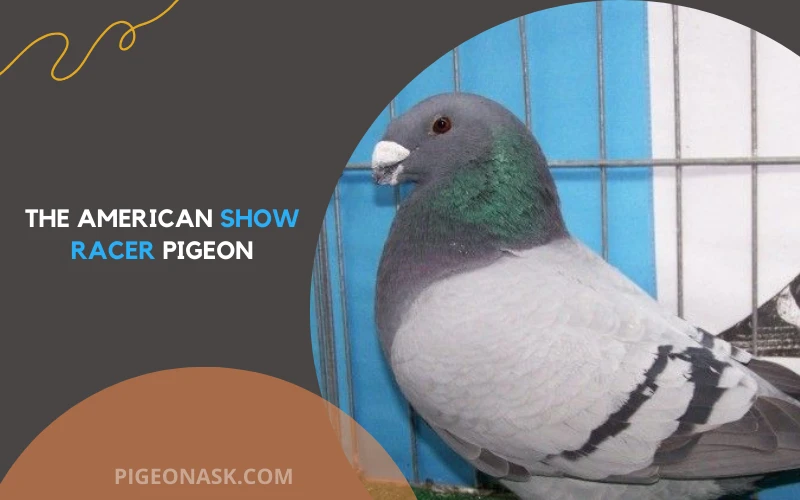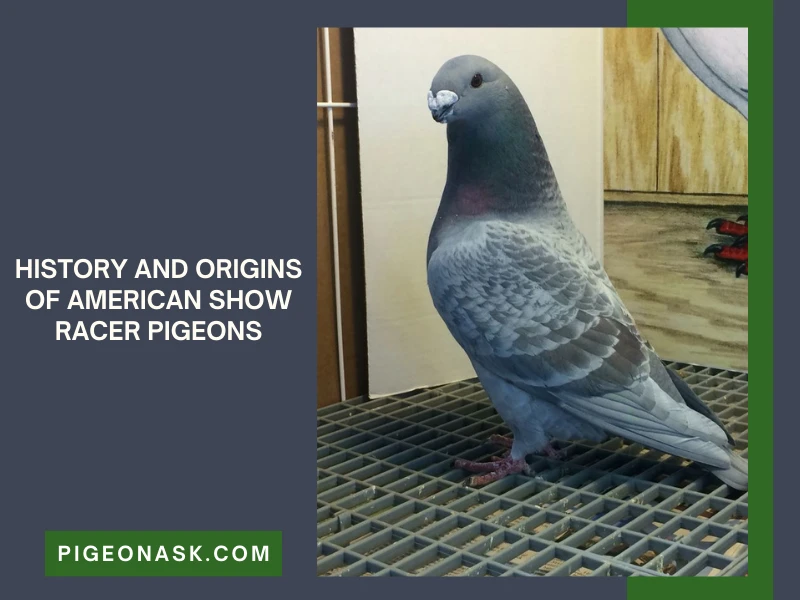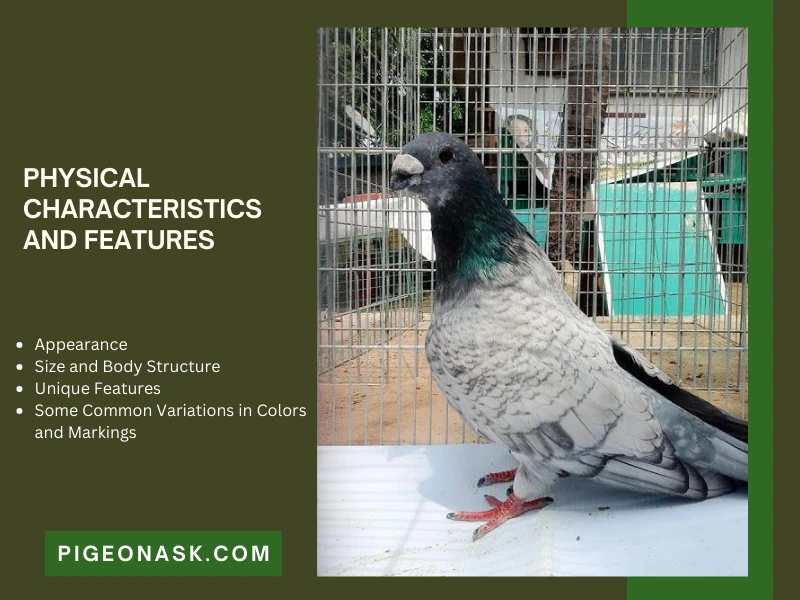American Show Racer Pigeon: Breed Guide
The American show racer pigeon is one of the largest breeds of domestic pigeons all around the United States.
These remarkable birds are not only your ordinary pigeons; they are a testament to the beauty and a rich history of pigeon fancying.
While the American Show Racer has the ability to race, the main purpose for breeding this magnificent bird is for exhibition. Plus, as they possess a tranquil nature, you can have them as wonderful pets.
Interested to know more about this pigeon, how to breed, and many more?

Then stay with us for the rest of the article and learn what you should do to breed them effectively.
American Show Racer Pigeon Profile
| Name | American Show Racer Pigeon |
|---|---|
| Scientific Name | Columba livia |
| Common Names | 01. Show Pen Racer 02. Show Racer |
| Origin | United States |
| Size | Average |
| Weight | 400 to 670 grams |
| Lifespan | On average 7 to 10 years |
| Physical Features | Short beaks, slender bodies, smooth chests, long narrow wings, and long tails |
| Temperament | Gentle |
| Behavior | Loyal and Social |
| Special Features | Unique head shape with short beak |
| Breeding and Maintenance | 01. Easy breeding 02. Requires low maintenance |
| Common or Popular Varieties | 01. Solid colors (blue, black, red, white) Show Racer 02. Patterned (splash, checkered, bar) Show Racer 03. Opal 04. Almond-colored 05. Blue Chequer 06. Red-white 07. Black-white 08. Blue-white |
Interested in similar topics on pigeon breed:
Overview
The American show racer pigeon is well known to the pigeon world as the Show Pen Racer. You might also know it by its nickname, which is the “Bird of Dignity.”
However, with time, the word “Pen” dropped off from its name, and these adorable birds are now known as the Show Racer all around the world, one of the chief domesticated pigeon breeds in the United States.
The Show Racer is bred for its beauty and speed. Pigeon enthusiasts mainly use them for show purposes, but for their excellent speed, they are also used for racing and other utility.
Plus, because of their distinct and enchanting color combinations, tremendous long-distance flying abilities, and excellent calm nature, they truly soar above the rest.
History And Origins of American Show Racer Pigeons
The story of the American Show Racer begins in the early 1900s in the United States.
At this time, pigeon lovers and breeders were captivated by the idea of creating a breed that would not only reflect aesthetic beauty but also have exceptional flight abilities.

The goal?
To develop a pigeon that would excel in the show arena while maintaining prowess in the skies.
In the 1950s, their idea took form when they started to crossbreed with different Racing Homers, known for their speed and agility.
Finally, the breeders skillfully combined different breed traits and gave birth to what we now know as the American Show Racer, a fantastic pigeon that can also make a good pet.
Physical Characteristics And Features
The Show Pen Racer is mostly average in size. But some of them are comparatively smaller than other pigeon breeds.
Smaller show racer pigeons can weigh around 400 grams or 14 ounces and the significantly bigger one can weigh up to 670 grams or 23.5 ounces.

Now, let’s take a gander at the common characteristics and features of these birdies.
Appearance
One of the standout features of the Show Racer Pigeon is their elegant and refined appearance, often described as regal.
They sport a well-arched neck, lending grace to their lovely posture. Moreover, you may notice they carry themselves with a certain stance and confidence, which makes them an amazing choice for exhibition.
Size and Body Structure
The American Show Racer pigeon strikes a balance between petite and large. The average body height of this pigeon is around 33 centimeters or 13 inches.
Their body is elongated and slender, which provides them a streamlined look.
Additionally, the distinct-shaped head with a short beak and long body is a key feature, accentuating their graceful presence.
Unique Features
There are some particular features that set the American Show Racer apart from other pigeon breeds.
They have a prominent, rounded forehead with a slightly curved beak. The beak is relatively short compared to others. It provides them with a particular look.
The high neck carriage is also a mentionable feature of this beautiful bird. Their proudly erect neck delivers a regal and majestic appearance.
Some Common Variations in Colors and Markings
These pigeons come in a wide variety of colors and markings, each with its unique charms and popularity among pigeon enthusiasts.
Here are some common and popular varieties of American Show Racer Pigeons:
- White: White Show Racers are known for their pure and clean appearance, making them a classic choice.
- Black: Black Show Racers are admired for their striking and sleek plumage.
- Red: These pigeons exhibit a rich and vibrant red hue, creating a warm and eye-catching presence.
- Blue: Blue Show Racers showcase a range of blue shades, from light powder blue to deep navy.
- Splash: Splash Show Racers have a unique and captivating pattern of splashed color across their feathers, creating a visually stunning effect.
- Checkered: Checkered varieties display a checkerboard-like pattern on their feathers and tails.
- Bar: Bar Show Racers have horizontal stripes or bars across their wings and body, adding a sense of rhythm to their appearance.
- Opal: Opal Show Racers exhibit a distinctive opalescent sheen on their feathers, delivering an ethereal and captivating look.
- Almond: Almond-colored Show Racers have a warm, tan hue that is less common but highly sought after.
- Color combinations: Combinations like red-white, black-white, and blue-white are also some common varieties of the Show Racer.
Distribution And Habitat
Like many domesticated pigeon breeds, the American Show Racer is primarily found in human-managed environments. But what are their habitat preferences and how do they interact with urban and rural settings?

Geographic Distribution
As they are domestic breeds created by selective breeding, they are not found in the wild. They are allocated worldwide, wherever pigeon enthusiasts like you or breeders reside.
Habitat Preferences
Show racers are commonly kept in pigeon lofts or aviaries. They thrive in captivity. Man-made shelters, safety, and nesting space are the habitual preferences of these birds.
A well-controlled environment with proper access to food, clean water, and protection from predators is a well-suited place for your Show Racer.
Urban and Rural Habitats
American Show Racer pigeons are primarily associated with urban and suburban areas. Pigeon fanciers who especially dwell in towns and cities are more likely to breed and keep these birds.
Why is that? Because in these settings, these pigeons have a consistent food source and are safe from the difficulties of the rural area or wild.
Migration and Seasonal Movement
While these birdies are a domesticated breed, they do not engage in any kind of long-distance migration, unlike other wild pigeons.
They remain confined within their lofts or aviaries throughout the year. Their controlled environment provides a safe habitat regardless of the season.
Threats and Conservation Status
American Show Racer pigeon is not considered a threatened or endangered species as they are home-bred.
However, they can face certain threats in their captivity. Possible threats such as diseases, parasites, and predation by birds of prey can be a vital concern for your American Show Racer.
So, your responsible breeding practices and proper care are essential for their well-being and overall health.
Behavior And Traits of American Show Racer Pigeons
In this section, we have evaluated the common behavior and traits that align with the personality of the American Show Racer.

Common Personality Traits
Show racers are well known for their gentle and friendly nature, which makes them approachable and sociable birds. If you take care of them with affection, they may show you the same. This excellent behavior makes them great pets.
In addition to that, if you are looking for a pigeon breed that makes hardly any noise, the American show racer can be the one for you.
With eye-catching appearance, tame nature, and low-maintenance requirements, these birdies have been the central attraction to pigeon lovers for many years now.
Diet
Just like other pigeons, Show Racer pigeons are granivores as well. Their diet plan consists of various seeds, grains, and pellets.
You can also treat them with fruits like berries and chopped vegetables like cabbage, lettuce, spinach, broccoli, cauliflower, kale, edamame beans, and so on.
Other than that, small insects and worms can also be included in their dietary plan for an overall healthy and nutritious intake.
Flight
In general, at the age of six weeks, baby pigeons gain the ability to fly. However, they start to flap their adorable wings from four weeks of age. The American Show Racer is no different.
They can reach up to 88 kilometers or around 55 miles per hour. And how far can they go? Well, through our research, we found that there is no exact measurement for that. But, according to some breeders, they can fly up to 300 miles.
While they possess good racing ability, it is not the primary reason for which they are bred.
Nesting, Breeding, and Courtship
The American Show Racer pigeons usually prefer later winter or early spring as their breeding time, whereas a general pigeon pair mates from March to June and August to November.
These pigeons require a warm and cozy place to hatch their eggs. Also, the place should be neat and clean. Otherwise, parasites or other diseases can take place.
Now, the fun part! You can provide them with twigs, straw, hay, or other stuff to make their nesting more effective.
Plus, make sure they have enough space to roam around in their aviaries, which will make the overall breeding procedure more efficient.
Once the nesting is complete, the female show racer lays two to three eggs.
Through the incubation time, Show Racer’s parents sit on the eggs gradually to keep them warm.
Afterward, the eggs need around 17 to 19 days to hatch. This time duration can differ sometimes because of different factors like weather and temperature.
Lifespan
The average lifespan of an American Show Racer is between seven to ten years. However, with proper management, nutrition, care, and consciousness, you can make them live up to twenty years.
Homing Instinct
Show Racer pigeons are loyal to their keepers. Additionally, they have a good memory. So, whenever you let them fly, they will eventually return to their home.
This instinct plays a significant role if you use them as pets. But, first, you have to train them for a while.
Breeding And Maintenance
Now, if you are willing to breed them, you must know that the breeding and maintaining of American Show Racer Pigeons require careful attention, dedication, and a nurturing environment.

Let’s explore the essential aspects of raising and breeding these captivating birds.
Information about Raising and Breeding
Show Racers can be bred throughout the year. But when is the perfect breeding season for them?
Well, you can breed them more successfully during the spring and summer.
Because at this time of the year, the days are much longer than usual. Plus, the natural daylight hours are optimal.
Now, the critical part is how do you select the breeding pairs?
Expert breeders often select pairs based on pigeons’ color, markings, and conformation. This procedure ensures the offspring meets the show standards.
After you select your desirable breed, the follow-on process goes on naturally.
Once the eggs are laid, male and female pigeon shares their incubation duties.
After hatching, the parents work together to feed and care for their babies.
During this time, proper nutrition is a vital thing to consider. Make sure you are providing the right nutrition values to the pigeon parents twice a day.
Tips and Considerations for Successful Breeding
Successful breeding always starts with a suitable nesting area. So, you better ensure an aviary for your Show Racer filled with nesting materials. Moreover, you should provide enough space for the pair so that it can operate easily.
An overall balanced diet is also essential for successful breeding, along with a clean and hygienic living environment.
To make sure your pigeons are healthy, keep a close eye on their behavior. Plus, consider cleaning and disinfecting the loft to prevent disturbance in the breeding process.
Thus, you can prevent any breeding complications and ensure successful breeding.
Feeding and Housing Requirements
Feed your American Show Racer Pigeon twice a day, providing sufficient water as they require. Additionally, according to your daily activities, you can generate a feeding schedule to keep your birds gratified.
In case you have several pairs of Show Racers, you should keep the food inside the shelter. Evaluate their daily food intake and consider giving them clean water in the morning and night.
Talking about the housing requirements, always provide a spacious and secure aviary where your birds can exercise and spread their wings.
Consider offering nesting boxes or shelves. This is because it will deliver privacy and protection for the breeding pairs.
Another thing to repute is the ventilation and temperature of your pigeon aviary, especially during harsh weather conditions. Remember, Show Racer pigeons are sensitive to temperature fluctuation.
Wrapping Things Up
And there you have it folks! The American Show Racer Pigeon is a bird of fascination to the pigeon enthusiast worldwide.
Throughout the years, it has created more and more hype between the breeders with its elegant appearance, unique features, friendly disposition, and other aptness.
However, whether you are drawn by their posture or breathtaking aerial displays, these birds leave an incredible mark on those fortunate enough to encounter them.
Was this post helpful? For more amazing informational pieces like this, follow us on our social media platforms Facebook, Twitter, and Pinterest.
